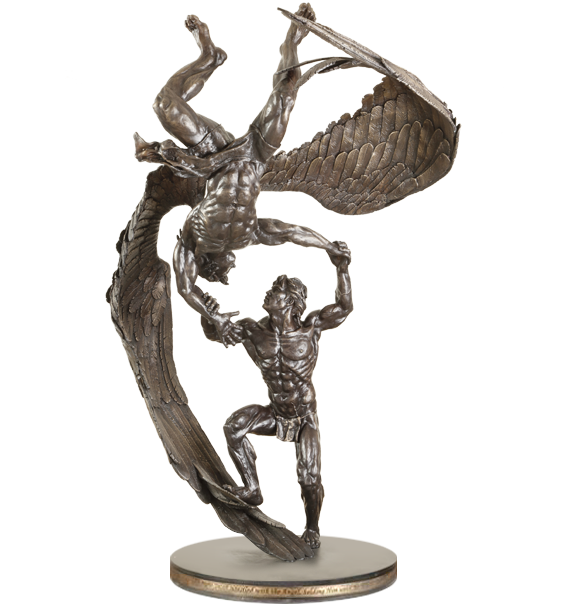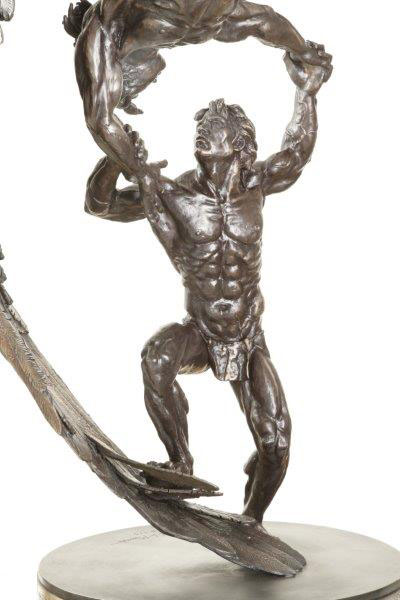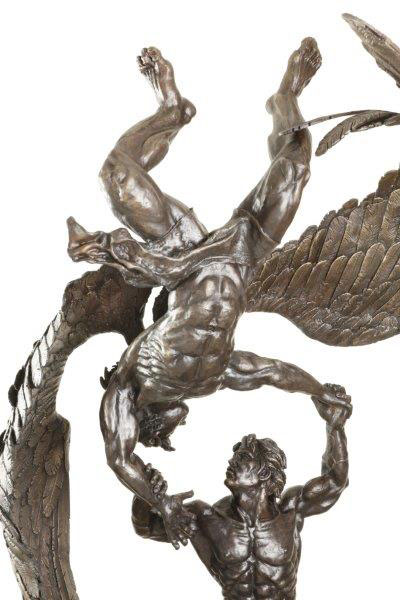 home
about
artists
exhibitions
press
contact
purchase
home
about
artists
exhibitions
press
contact
purchase |
|||||
|
RICHARD L. MINNS BIBLICAL SCRIPTURE: All night Jacob wrestled with the Angel, holding Him until He forgave Jacob of his sins and blessed him. The Angel resisted. At daybreak the Angel forgave and blessed Jacob stating: ‘Thy name shall be called no more Jacob, but now Israel: for as a prince hast thou power with God and with men, and hast prevailed.’” GENESIS, Chapter 13 DESCRIPTION OF SCULPTURE Richard Minns considers this to be his greatest work. To better understand what the sculpture portrays, it is helpful to revisit the Biblical scripture in more detail.
JACOB WRESTLES THE ANGEL: The original story of redemption
Jacob prayed to G-d all night to forgive him of his sin of receiving his brother’s blessing by fraud. An Angel suddenly stood before Jacob, denying G-d’s forgiveness for Jacob’s wrong. As the Angel, indifferent to Jacob’s pleas, turns to leave him, Jacob lays hold of the Angel and will not let Him go until the Angel forgives Jacob of his sins. Jacob wrestles with the Angel all night, holding him while pleading and repenting his sins.
The Angel could have easily used his supernatural power to force himself from Jacob’s grasp, but he chose not to do so. Instead he decided to test the power of Jacob’s faith. To see if Jacob’s faith was strong enough to also endure extreme bodily pain, the Angel touched Jacob’s thigh, throwing it immediately out of joint. But Jacob still hung on.
Finally, at daybreak, the Angel, speaking for G-d, forgave Jacob of his sins and blessed him. And the Angel said: “Henceforth Thy name shall be called no more Jacob, but now ISRAEL, for as a prince hast thou power with G-d and with men, and hast prevailed.” Many artists, sculptors, writers and poets have made their interpretation of this, the Bible’s first story of redemption. Artists include Rembrandt, Delacroix, Alexander Leloir, Bonnat, Moreau, Paul Gauguin, Marc Chagall, Sir Jacob Epstein and even in the U2 song “Bullet in the Blue Sky”. Richard now enters the classical ring with his own unique Interpretation. Richard’s Jacob stands erect and strong, holding the Angel fast. The Angel is in the air, head down facing Jacob, almost perpendicular to Jacob and the ground. The Angel’s oversize wings form a perfect “S” shape, effectively framing the sculpture. One wing is high in the air. The other wing curves to the ground and Jacob holds it under his right foot, thus preventing the Angel’s flight. This sculpture reflects the combined influence of Michelangelo and Auguste Rodin: powerful, realistic and physical, with anatomical perfection, highly charged with maximum emotion and movement. The graceful conflict of two handsome physically perfect forms straining every muscle, sinew and vein in a contest of strength would certainly have invoked all of the old master’s creative powers. Jacob’s face shows intense determination. He holds the Angel fast, pleading for forgiveness. The Angel, who could break away from Jacob any time, is not straining at all and has a look of ambivalence bordering on amusement on his face. Richard sculpted the figure of Jacob and the figure of the Angel in plasticina. Then an exacting rubber mold was made of each, producing a negative impression. Then melted wax was poured into the negative mold, creating a positive wax of both Jacob and the Angel. This was necessary because after the wax Jacob and the Angel were attached together, the Angel’s wings were slowly sculpted out of wax. Richard’s treatment of the Angel’s wings set this sculpture apart from all other sculptures. SCULPTING THE ANGEL’S WINGS WITH 625 HAND CARVED FEATHERS: Richard first made a careful study of birds’ wings, especially those of the Golden Eagle. Then sheets of molten wax were prepared. Then every single feather was hand carved to perfection, carving each rib in every feather. Then each single feather was carefully placed on the wing armature, with multi-layers of feathers on each side of the wings, overlapping each other the exact way they would grow on a mature eagle. The result is a dramatic realistic effect, impossible to achieve by just doing surface modeling on a clay, plasticina or marble slab. Each of over 625 different hand carved feathers were carefully placed one-by-one, overlapping each other until these magnificent wings were created. The sculpture is mounted on a large circular 60cm x 60cm base, with most of the above Biblical scripture engraved in bronze and circling around the base like the “SAMSON SLAYS THE LION” bronze. The sculpture is in a classic potash rich dark brown patination, resembling the best of 19th century patination. Special highlights are on the feathers of the wings so under a proper light, the sculpture comes alive. ARTIST’S INTERPRETATION “The story of Jacob and the Angel has always intrigued me and it has always been on my “Things to Do List”. First, I studied what every artist and sculptor did before me. I recently visited Sir Jacob Epstein’s marble classic of Jacob and the Angel on key display at the London Tate Modern, and the masterpiece paintings of Rembrandt, Delacroix, Alexander Leloir, Bonnat, Moreau, Paul Gauguin and Marc Chagall. All interpretations had one thing in common: both Jacob and the angel with wings were wrestling standing on the ground.” “It was obvious to me that if the Angel was standing on the ground, his wings were only a useless decoration. It was obvious to me that the angel must be in the air using his large magnificent wings. How could all these great artists / sculptors have missed this? The minute I decided to put the Angel in the air, I was bursting with enthusiasm since this opened the door to many exciting possibilities.” “I made countless stick figures until I arrived at the right position of Jacob and the Angel. Then I knew I had four (4) elements to contend with: (1) Jacob, (2) the Angel, (3) the Angel’s left wing, and (4) the Angel’s right wing. Slowly … all the elements fell in place. Then I had to have an armature constructed that would adequately support each element.” “Many of the old masters have had a major influence on me. But Michelangelo and Rodin head the list. And, amazingly, neither Michelangelo nor Auguste Rodin had interpreted Jacob and the Angel. So I asked myself how would these two masters have done Jacob and the Angel? I am told that my interpretation shows an equal influence of both masters.” “In many of my sculptures, the bronze surface is made very smooth. This “final smoothing” is done under my supervision on the final wax and then again on the final bronze. “Smoothing” has its advantages, but sometimes the initial modeling details are compromised. This sculpture has not undergone the “smoothing” process. This sculpture is all in “natural finish”, the way Rodin worked, preserving every detail of anatomy, muscles, tendons and veins … preserving the energy and the touch of the artist. Less polished, but immensely powerful and moving.” “In my view, this is, indeed, my best work. It took many months in preliminary research, advance planning, countless sketches, to arrive at the proper position and movement, the modeling of Jacob and the Angel in plasticina, then conversion to wax … and finally the Angel’s wings, which took on a life of their own.” “I hope that you enjoy this half as much as I enjoyed creating it.” Richard L. Minns
|
|||||
|
|
|||||




